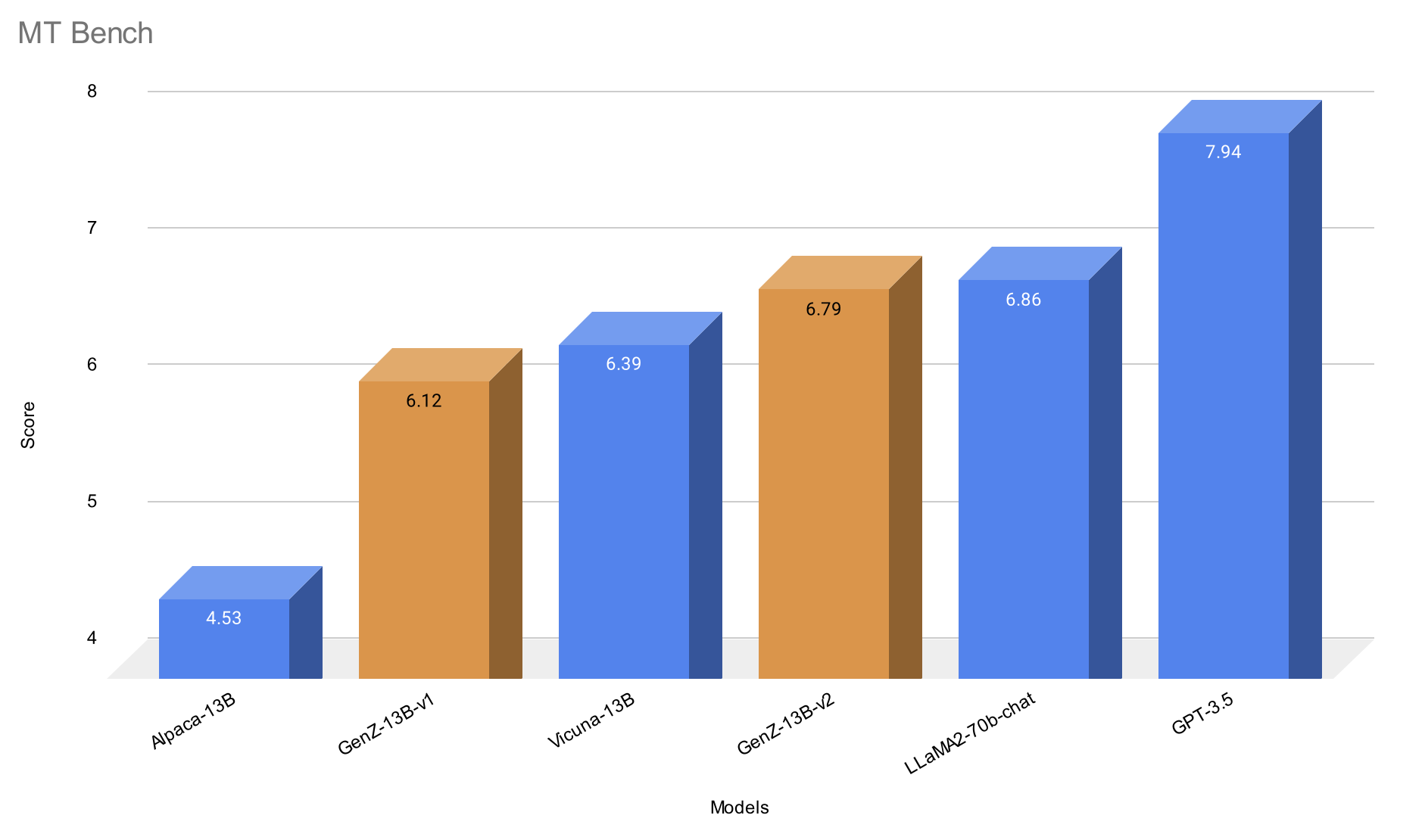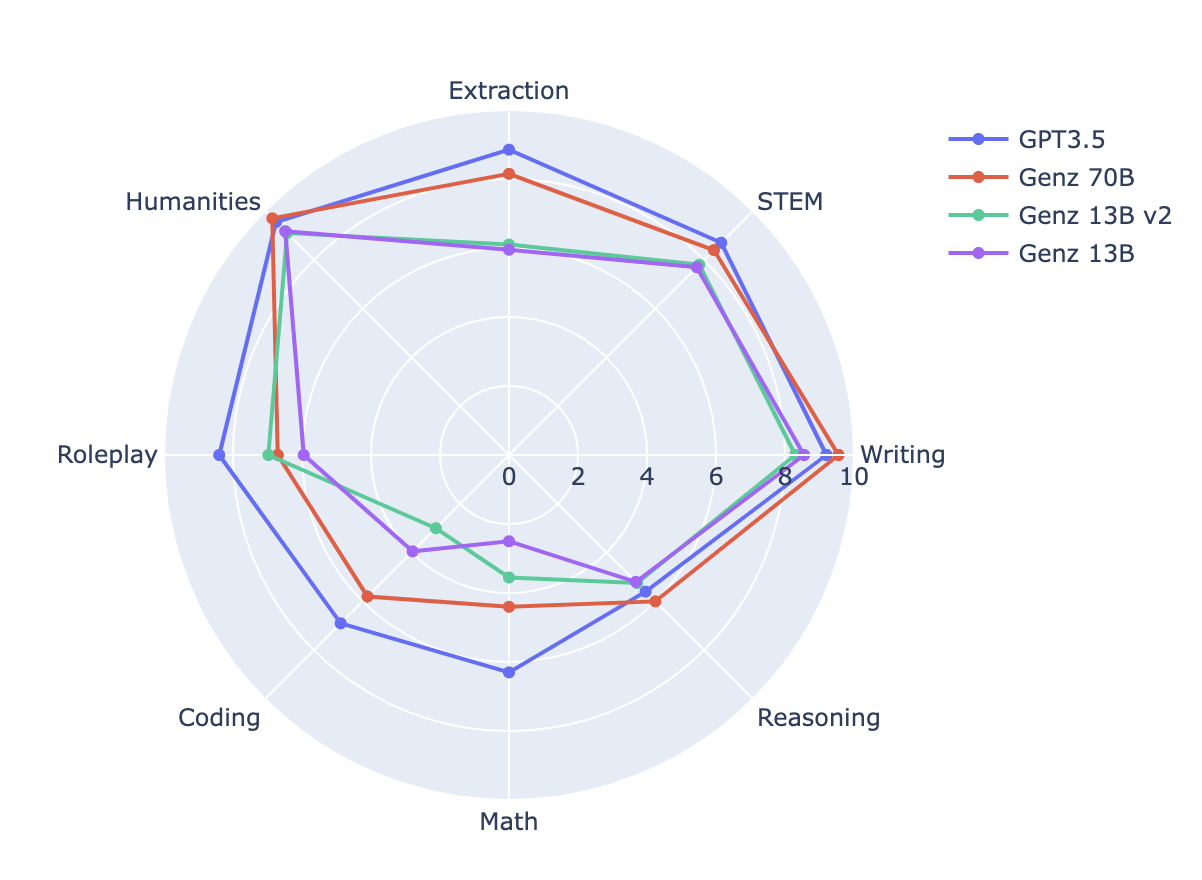---
inference: false
language:
- en
library_name: transformers
license: llama2
model_creator: Bud
model_link: https://huggingface.co/budecosystem/genz-70b
model_name: GenZ 70B
model_type: llama
pipeline_tag: text-generation
quantized_by: TheBloke
---

# GenZ 70B - GGML
- Model creator: [Bud](https://huggingface.co/budecosystem)
- Original model: [GenZ 70B](https://huggingface.co/budecosystem/genz-70b)
## Description
This repo contains GGML format model files for [Bud's GenZ 70B](https://huggingface.co/budecosystem/genz-70b).
### Important note regarding GGML files.
The GGML format has now been superseded by GGUF. As of August 21st 2023, [llama.cpp](https://github.com/ggerganov/llama.cpp) no longer supports GGML models. Third party clients and libraries are expected to still support it for a time, but many may also drop support.
### About GGML
GPU acceleration is now available for Llama 2 70B GGML files, with both CUDA (NVidia) and Metal (macOS). The following clients/libraries are known to work with these files, including with GPU acceleration:
* [llama.cpp](https://github.com/ggerganov/llama.cpp), commit `e76d630` and later.
* [text-generation-webui](https://github.com/oobabooga/text-generation-webui), the most widely used web UI.
* [KoboldCpp](https://github.com/LostRuins/koboldcpp), version 1.37 and later. A powerful GGML web UI, especially good for story telling.
* [LM Studio](https://lmstudio.ai/), a fully featured local GUI with GPU acceleration for both Windows and macOS. Use 0.1.11 or later for macOS GPU acceleration with 70B models.
* [llama-cpp-python](https://github.com/abetlen/llama-cpp-python), version 0.1.77 and later. A Python library with LangChain support, and OpenAI-compatible API server.
* [ctransformers](https://github.com/marella/ctransformers), version 0.2.15 and later. A Python library with LangChain support, and OpenAI-compatible API server.
## Repositories available
* [GPTQ models for GPU inference, with multiple quantisation parameter options.](https://huggingface.co/TheBloke/Genz-70b-GPTQ)
* [2, 3, 4, 5, 6 and 8-bit GGUF models for CPU+GPU inference](https://huggingface.co/TheBloke/Genz-70b-GGUF)
* [2, 3, 4, 5, 6 and 8-bit GGML models for CPU+GPU inference (deprecated)](https://huggingface.co/TheBloke/Genz-70b-GGML)
* [Bud's original unquantised fp16 model in pytorch format, for GPU inference and for further conversions](https://huggingface.co/budecosystem/genz-70b)
## Prompt template: User-Assistant-Newlines
```
### User:
{prompt}
### Assistant:
```
## Compatibility
### Works with llama.cpp [commit `e76d630`](https://github.com/ggerganov/llama.cpp/commit/e76d630df17e235e6b9ef416c45996765d2e36fb) until August 21st, 2023
Will not work with `llama.cpp` after commit [dadbed99e65252d79f81101a392d0d6497b86caa](https://github.com/ggerganov/llama.cpp/commit/dadbed99e65252d79f81101a392d0d6497b86caa).
For compatibility with latest llama.cpp, please use GGUF files instead.
Or one of the other tools and libraries listed above.
To use in llama.cpp, you must add `-gqa 8` argument.
For other UIs and libraries, please check the docs.
## Explanation of the new k-quant methods
Click to see details
The new methods available are:
* GGML_TYPE_Q2_K - "type-1" 2-bit quantization in super-blocks containing 16 blocks, each block having 16 weight. Block scales and mins are quantized with 4 bits. This ends up effectively using 2.5625 bits per weight (bpw)
* GGML_TYPE_Q3_K - "type-0" 3-bit quantization in super-blocks containing 16 blocks, each block having 16 weights. Scales are quantized with 6 bits. This end up using 3.4375 bpw.
* GGML_TYPE_Q4_K - "type-1" 4-bit quantization in super-blocks containing 8 blocks, each block having 32 weights. Scales and mins are quantized with 6 bits. This ends up using 4.5 bpw.
* GGML_TYPE_Q5_K - "type-1" 5-bit quantization. Same super-block structure as GGML_TYPE_Q4_K resulting in 5.5 bpw
* GGML_TYPE_Q6_K - "type-0" 6-bit quantization. Super-blocks with 16 blocks, each block having 16 weights. Scales are quantized with 8 bits. This ends up using 6.5625 bpw
* GGML_TYPE_Q8_K - "type-0" 8-bit quantization. Only used for quantizing intermediate results. The difference to the existing Q8_0 is that the block size is 256. All 2-6 bit dot products are implemented for this quantization type.
Refer to the Provided Files table below to see what files use which methods, and how.
## Provided files
| Name | Quant method | Bits | Size | Max RAM required | Use case |
| ---- | ---- | ---- | ---- | ---- | ----- |
| [genz-70b.ggmlv3.Q2_K.bin](https://huggingface.co/TheBloke/Genz-70b-GGML/blob/main/genz-70b.ggmlv3.Q2_K.bin) | Q2_K | 2 | 28.59 GB| 31.09 GB | New k-quant method. Uses GGML_TYPE_Q4_K for the attention.vw and feed_forward.w2 tensors, GGML_TYPE_Q2_K for the other tensors. |
| [genz-70b.ggmlv3.Q3_K_S.bin](https://huggingface.co/TheBloke/Genz-70b-GGML/blob/main/genz-70b.ggmlv3.Q3_K_S.bin) | Q3_K_S | 3 | 29.75 GB| 32.25 GB | New k-quant method. Uses GGML_TYPE_Q3_K for all tensors |
| [genz-70b.ggmlv3.Q3_K_M.bin](https://huggingface.co/TheBloke/Genz-70b-GGML/blob/main/genz-70b.ggmlv3.Q3_K_M.bin) | Q3_K_M | 3 | 33.04 GB| 35.54 GB | New k-quant method. Uses GGML_TYPE_Q4_K for the attention.wv, attention.wo, and feed_forward.w2 tensors, else GGML_TYPE_Q3_K |
| [genz-70b.ggmlv3.Q3_K_L.bin](https://huggingface.co/TheBloke/Genz-70b-GGML/blob/main/genz-70b.ggmlv3.Q3_K_L.bin) | Q3_K_L | 3 | 36.15 GB| 38.65 GB | New k-quant method. Uses GGML_TYPE_Q5_K for the attention.wv, attention.wo, and feed_forward.w2 tensors, else GGML_TYPE_Q3_K |
| [genz-70b.ggmlv3.Q4_0.bin](https://huggingface.co/TheBloke/Genz-70b-GGML/blob/main/genz-70b.ggmlv3.Q4_0.bin) | Q4_0 | 4 | 38.87 GB| 41.37 GB | Original quant method, 4-bit. |
| [genz-70b.ggmlv3.Q4_K_S.bin](https://huggingface.co/TheBloke/Genz-70b-GGML/blob/main/genz-70b.ggmlv3.Q4_K_S.bin) | Q4_K_S | 4 | 38.87 GB| 41.37 GB | New k-quant method. Uses GGML_TYPE_Q4_K for all tensors |
| [genz-70b.ggmlv3.Q4_K_M.bin](https://huggingface.co/TheBloke/Genz-70b-GGML/blob/main/genz-70b.ggmlv3.Q4_K_M.bin) | Q4_K_M | 4 | 41.38 GB| 43.88 GB | New k-quant method. Uses GGML_TYPE_Q6_K for half of the attention.wv and feed_forward.w2 tensors, else GGML_TYPE_Q4_K |
| [genz-70b.ggmlv3.Q4_1.bin](https://huggingface.co/TheBloke/Genz-70b-GGML/blob/main/genz-70b.ggmlv3.Q4_1.bin) | Q4_1 | 4 | 43.17 GB| 45.67 GB | Original quant method, 4-bit. Higher accuracy than q4_0 but not as high as q5_0. However has quicker inference than q5 models. |
| [genz-70b.ggmlv3.Q5_0.bin](https://huggingface.co/TheBloke/Genz-70b-GGML/blob/main/genz-70b.ggmlv3.Q5_0.bin) | Q5_0 | 5 | 47.46 GB| 49.96 GB | Original quant method, 5-bit. Higher accuracy, higher resource usage and slower inference. |
| [genz-70b.ggmlv3.Q5_K_S.bin](https://huggingface.co/TheBloke/Genz-70b-GGML/blob/main/genz-70b.ggmlv3.Q5_K_S.bin) | Q5_K_S | 5 | 47.46 GB| 49.96 GB | New k-quant method. Uses GGML_TYPE_Q5_K for all tensors |
| [genz-70b.ggmlv3.Q5_K_M.bin](https://huggingface.co/TheBloke/Genz-70b-GGML/blob/main/genz-70b.ggmlv3.Q5_K_M.bin) | Q5_K_M | 5 | 48.75 GB| 51.25 GB | New k-quant method. Uses GGML_TYPE_Q6_K for half of the attention.wv and feed_forward.w2 tensors, else GGML_TYPE_Q5_K |
**Note**: the above RAM figures assume no GPU offloading. If layers are offloaded to the GPU, this will reduce RAM usage and use VRAM instead.
## How to run in `llama.cpp`
Make sure you are using `llama.cpp` from commit [dadbed99e65252d79f81101a392d0d6497b86caa](https://github.com/ggerganov/llama.cpp/commit/dadbed99e65252d79f81101a392d0d6497b86caa) or earlier.
For compatibility with latest llama.cpp, please use GGUF files instead.
I use the following command line; adjust for your tastes and needs:
```
./main -t 10 -ngl 40 -gqa 8 -m genz-70b.ggmlv3.q4_K_M.bin --color -c 4096 --temp 0.7 --repeat_penalty 1.1 -n -1 -p "### User:\nWrite a story about llamas\n\n### Assistant:\n"
```
Change `-t 10` to the number of physical CPU cores you have. For example if your system has 8 cores/16 threads, use `-t 8`. If you are fully offloading the model to GPU, use `-t 1`
Change `-ngl 40` to the number of GPU layers you have VRAM for. Use `-ngl 100` to offload all layers to VRAM - if you have a 48GB card, or 2 x 24GB, or similar. Otherwise you can partially offload as many as you have VRAM for, on one or more GPUs.
If you want to have a chat-style conversation, replace the `-p ` argument with `-i -ins`
Remember the `-gqa 8` argument, required for Llama 70B models.
Change `-c 4096` to the desired sequence length for this model. For models that use RoPE, add `--rope-freq-base 10000 --rope-freq-scale 0.5` for doubled context, or `--rope-freq-base 10000 --rope-freq-scale 0.25` for 4x context.
For other parameters and how to use them, please refer to [the llama.cpp documentation](https://github.com/ggerganov/llama.cpp/blob/master/examples/main/README.md)
## How to run in `text-generation-webui`
Further instructions here: [text-generation-webui/docs/llama.cpp-models.md](https://github.com/oobabooga/text-generation-webui/blob/main/docs/llama.cpp-models.md).
## Discord
For further support, and discussions on these models and AI in general, join us at:
[TheBloke AI's Discord server](https://discord.gg/theblokeai)
## Thanks, and how to contribute.
Thanks to the [chirper.ai](https://chirper.ai) team!
I've had a lot of people ask if they can contribute. I enjoy providing models and helping people, and would love to be able to spend even more time doing it, as well as expanding into new projects like fine tuning/training.
If you're able and willing to contribute it will be most gratefully received and will help me to keep providing more models, and to start work on new AI projects.
Donaters will get priority support on any and all AI/LLM/model questions and requests, access to a private Discord room, plus other benefits.
* Patreon: https://patreon.com/TheBlokeAI
* Ko-Fi: https://ko-fi.com/TheBlokeAI
**Special thanks to**: Aemon Algiz.
**Patreon special mentions**: Kacper Wikieł, knownsqashed, Leonard Tan, Asp the Wyvern, Daniel P. Andersen, Luke Pendergrass, Stanislav Ovsiannikov, RoA, Dave, Ai Maven, Kalila, Will Dee, Imad Khwaja, Nitin Borwankar, Joseph William Delisle, Tony Hughes, Cory Kujawski, Rishabh Srivastava, Russ Johnson, Stephen Murray, Lone Striker, Johann-Peter Hartmann, Elle, J, Deep Realms, SuperWojo, Raven Klaugh, Sebastain Graf, ReadyPlayerEmma, Alps Aficionado, Mano Prime, Derek Yates, Gabriel Puliatti, Mesiah Bishop, Magnesian, Sean Connelly, biorpg, Iucharbius, Olakabola, Fen Risland, Space Cruiser, theTransient, Illia Dulskyi, Thomas Belote, Spencer Kim, Pieter, John Detwiler, Fred von Graf, Michael Davis, Swaroop Kallakuri, subjectnull, Clay Pascal, Subspace Studios, Chris Smitley, Enrico Ros, usrbinkat, Steven Wood, alfie_i, David Ziegler, Willem Michiel, Matthew Berman, Andrey, Pyrater, Jeffrey Morgan, vamX, LangChain4j, Luke @flexchar, Trenton Dambrowitz, Pierre Kircher, Alex, Sam, James Bentley, Edmond Seymore, Eugene Pentland, Pedro Madruga, Rainer Wilmers, Dan Guido, Nathan LeClaire, Spiking Neurons AB, Talal Aujan, zynix, Artur Olbinski, Michael Levine, 阿明, K, John Villwock, Nikolai Manek, Femi Adebogun, senxiiz, Deo Leter, NimbleBox.ai, Viktor Bowallius, Geoffrey Montalvo, Mandus, Ajan Kanaga, ya boyyy, Jonathan Leane, webtim, Brandon Frisco, danny, Alexandros Triantafyllidis, Gabriel Tamborski, Randy H, terasurfer, Vadim, Junyu Yang, Vitor Caleffi, Chadd, transmissions 11
Thank you to all my generous patrons and donaters!
And thank you again to a16z for their generous grant.
# Original model card: Bud's GenZ 70B
---
~ GenZ ~

Democratizing access to LLMs for the open-source community.
Let's advance AI, together.
---
## Introduction 🎉
Welcome to **GenZ**, an advanced Large Language Model (LLM) fine-tuned on the foundation of Meta's open-source Llama V2 70B parameter model. At Bud Ecosystem, we believe in the power of open-source collaboration to drive the advancement of technology at an accelerated pace. Our vision is to democratize access to fine-tuned LLMs, and to that end, we will be releasing a series of models across different parameter counts (7B, 13B, and 70B) and quantizations (32-bit and 4-bit) for the open-source community to use, enhance, and build upon.

The smaller quantization version of our models makes them more accessible, enabling their use even on personal computers. This opens up a world of possibilities for developers, researchers, and enthusiasts to experiment with these models and contribute to the collective advancement of language model technology.
GenZ isn't just a powerful text generator—it's a sophisticated AI assistant, capable of understanding and responding to user prompts with high-quality responses. We've taken the robust capabilities of Llama V2 and fine-tuned them to offer a more user-focused experience. Whether you're seeking informative responses or engaging interactions, GenZ is designed to deliver.
And this isn't the end. It's just the beginning of a journey towards creating more advanced, more efficient, and more accessible language models. We invite you to join us on this exciting journey. 🚀
---
Milestone Releases ️🏁
**[21 August 2023]**
[_GenZ-70B_](https://huggingface.co/budecosystem/genz-70b) : We're excited to announce the release of our Genz 70BB model. Experience the advancements by downloading the model from [HuggingFace](https://huggingface.co/budecosystem/genz-70b).
**[27 July 2023]**
[_GenZ-13B V2 (ggml)_](https://huggingface.co/budecosystem/genz-13b-v2-ggml) : Announcing our GenZ-13B v2 with ggml. This variant of GenZ can run inferencing using only CPU and without the need of GPU. Download the model from [HuggingFace](https://huggingface.co/budecosystem/genz-13b-v2-ggml).
**[27 July 2023]**
[_GenZ-13B V2 (4-bit)_](https://huggingface.co/budecosystem/genz-13b-v2-4bit) : Announcing our GenZ-13B v2 with 4-bit quantisation. Enabling inferencing with much lesser GPU memory than the 32-bit variant. Download the model from [HuggingFace](https://huggingface.co/budecosystem/genz-13b-v2-4bit).
**[26 July 2023]**
[_GenZ-13B V2_](https://huggingface.co/budecosystem/genz-13b-v2) : We're excited to announce the release of our Genz 13B v2 model, a step forward with improved evaluation results compared to v1. Experience the advancements by downloading the model from [HuggingFace](https://huggingface.co/budecosystem/genz-13b-v2).
**[20 July 2023]**
[_GenZ-13B_](https://huggingface.co/budecosystem/genz-13b) : We marked an important milestone with the release of the Genz 13B model. The journey began here, and you can partake in it by downloading the model from [Hugging Face](https://huggingface.co/budecosystem/genz-13b).
---
Getting Started on Hugging Face 🤗
Getting up and running with our models on Hugging Face is a breeze. Follow these steps:
1️⃣ : Import necessary modules
Start by importing the necessary modules from the ‘transformers’ library and ‘torch’.
```python
import torch
from transformers import AutoTokenizer, AutoModelForCausalLM
tokenizer = AutoTokenizer.from_pretrained("budecosystem/genz-70b", trust_remote_code=True)
model = AutoModelForCausalLM.from_pretrained("budecosystem/genz-70b", torch_dtype=torch.bfloat16, rope_scaling={"type": "dynamic", "factor": 2})
prompt = "### User:\nWrite a python flask code for login management\n\n### Assistant:\n"
inputs = tokenizer(prompt, return_tensors="pt")
sample = model.generate(**inputs, max_length=128)
print(tokenizer.decode(sample[0]))
```
Want to interact with the model in a more intuitive way? We have a Gradio interface set up for that. Head over to our GitHub page, clone the repository, and run the ‘generate.py’ script to try it out. Happy experimenting! 😄
Why Use GenZ? 💡
You might be wondering, "Why should I choose GenZ over a pretrained model?" The answer lies in the extra mile we've gone to fine-tune our models.
While pretrained models are undeniably powerful, GenZ brings something extra to the table. We've fine-tuned it with curated datasets, which means it has additional skills and capabilities beyond what a pretrained model can offer. Whether you need it for a simple task or a complex project, GenZ is up for the challenge.
What's more, we are committed to continuously enhancing GenZ. We believe in the power of constant learning and improvement. That's why we'll be regularly fine-tuning our models with various curated datasets to make them even better. Our goal is to reach the state of the art and beyond - and we're committed to staying the course until we get there.
But don't just take our word for it. We've provided detailed evaluations and performance details in a later section, so you can see the difference for yourself.
Choose GenZ and join us on this journey. Together, we can push the boundaries of what's possible with large language models.
---
Model Card for GenZ 70B 📄
Here's a quick overview of everything you need to know about GenZ 70B.
Model Details:
- Developed by: Bud Ecosystem
- Base pretrained model type: Llama V2 70B
- Model Architecture: GenZ 70B, fine-tuned on Llama V2 70B, is an auto-regressive language model that employs an optimized transformer architecture. The fine-tuning process for GenZ 70B leveraged Supervised Fine-Tuning (SFT)
- License: The model is available for commercial use under a custom commercial license. For more information, please visit: [Meta AI Model and Library Downloads](https://ai.meta.com/resources/models-and-libraries/llama-downloads/)
---
Intended Use 💼
When we created GenZ 70B, we had a clear vision of how it could be used to push the boundaries of what's possible with large language models. We also understand the importance of using such models responsibly. Here's a brief overview of the intended and out-of-scope uses for GenZ 70B.
Direct Use
GenZ 70B is designed to be a powerful tool for research on large language models. It's also an excellent foundation for further specialization and fine-tuning for specific use cases, such as:
- Text summarization
- Text generation
- Chatbot creation
- And much more!
Out-of-Scope Use 🚩
While GenZ 70B is versatile, there are certain uses that are out of scope:
- Production use without adequate assessment of risks and mitigation
- Any use cases which may be considered irresponsible or harmful
- Use in any manner that violates applicable laws or regulations, including trade compliance laws
- Use in any other way that is prohibited by the Acceptable Use Policy and Licensing Agreement for Llama 2
Remember, GenZ 70B, like any large language model, is trained on a large-scale corpora representative of the web, and therefore, may carry the stereotypes and biases commonly encountered online.
Recommendations 🧠
We recommend users of GenZ 70B to consider fine-tuning it for the specific set of tasks of interest. Appropriate precautions and guardrails should be taken for any production use. Using GenZ 70B responsibly is key to unlocking its full potential while maintaining a safe and respectful environment.
---
Training Details 📚
When fine-tuning GenZ 70B, we took a meticulous approach to ensure we were building on the solid base of the pretrained Llama V2 70B model in the most effective way. Here's a look at the key details of our training process:
Fine-Tuning Training Data
For the fine-tuning process, we used a carefully curated mix of datasets. These included data from OpenAssistant, an instruction fine-tuning dataset, and Thought Source for the Chain Of Thought (CoT) approach. This diverse mix of data sources helped us enhance the model's capabilities across a range of tasks.
Hyperparameters
Here are the hyperparameters we used for fine-tuning:
| Hyperparameter | Value |
| -------------- | ----- |
| Warmup Ratio | 0.04 |
| Learning Rate Scheduler Type | Cosine |
| Learning Rate | 2e-5 |
| Number of Training Epochs | 3 |
| Per Device Training Batch Size | 4 |
| Gradient Accumulation Steps | 4 |
| Precision | FP16 |
| Optimizer | AdamW |
---
Evaluations 🎯
Evaluating our model is a key part of our fine-tuning process. It helps us understand how our model is performing and how it stacks up against other models. Here's a look at some of the key evaluations for GenZ 70B:
Benchmark Comparison
We've compared GenZ models to understand the improvements our fine-tuning has achieved.
| Model Name | MT Bench | MMLU | Human Eval | Hellaswag | BBH |
|:----------:|:--------:|:----:|:----------:|:---------:|:----:|
| Genz 13B | 6.12 | 53.62| 17.68 | 77.38 | 37.76|
| Genz 13B v2| 6.79 | 53.68| 21.95 | 77.48 | 38.1 |
| Genz 70B | 7.33 | 70.32| | | |
MT Bench Score
A key evaluation metric we use is the MT Bench score. This score provides a comprehensive assessment of our model's performance across a range of tasks.

---
Looking Ahead 👀
We're excited about the journey ahead with GenZ. We're committed to continuously improving and enhancing our models, and we're excited to see what the open-source community will build with them. We believe in the power of collaboration, and we can't wait to see what we can achieve together.
Remember, we're just getting started. This is just the beginning of a journey that we believe will revolutionize the world of large language models. We invite you to join us on this exciting journey. Together, we can push the boundaries of what's possible with AI. 🚀
---
Check the GitHub for the code -> [GenZ](https://raw.githubusercontent.com/BudEcosystem/GenZ)




